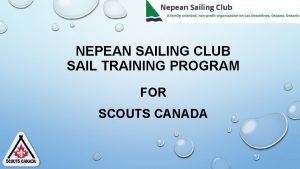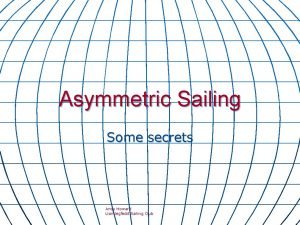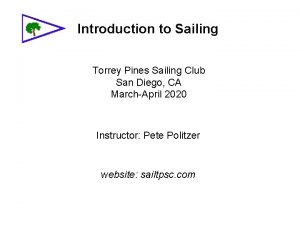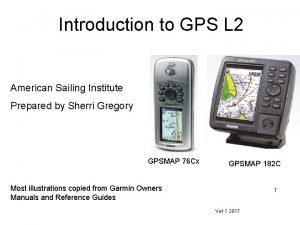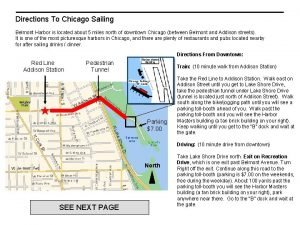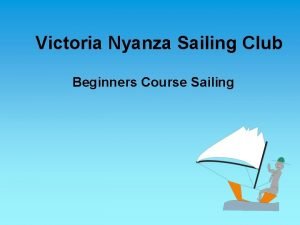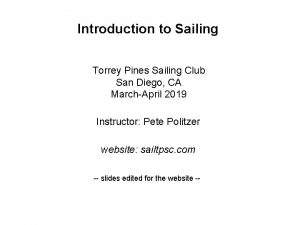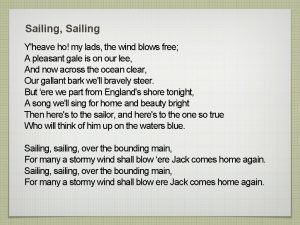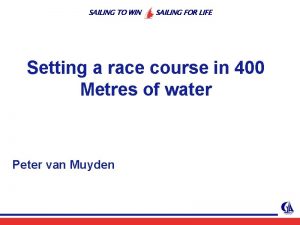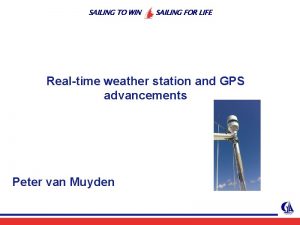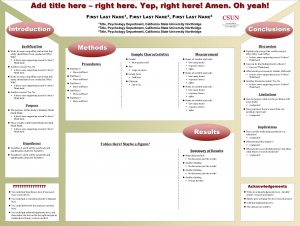Sailing 102 Sailing 102 Here are some of
































- Slides: 32

Sailing 102

Sailing 102 Here are some of fundamental elements of sailing, broken down into digestible segments. 1. 2. 3. 4. Tacking Gibing Upwind Sailing (Knot review)

Sailing 102 - Tacking Wind Awareness REMEMBER THIS FROM SAILING 101? ● Sail boats cannot sail directly into the wind. ● Knowing where the wind is coming from allows you to control your boat. That’s why we need to be able to tack. ● Wind direction shifts often, especially on lakes.

Tacking Overview What is tacking? ● Turning the boat through the wind ● The boat crosses the "No Go Zone" ● We can't sail directly into the wind Why do we tack? During the tack, the boat is not receiving power from the wind. So forward momentum allows it to coast through, if you do it smoothly.

When do we tack? ● Reversing course or "zig-zaging" to reach an upwind destination Illustration from US Sailing Start Sailing Right

How do we tack the first time? ● Your first sail begins with the wind directly on the side of your sailboat (beam reach) ● You pick a reference point behind you, push the tiller toward the sail, and hold it until the boat "comes about" (180 degrees)

Beginners tack from broad reach to broad reach Later, you will usually tack from close hauled to close hauled

Procedure You can practice tacking on the land. Remembering which way to move the tiller can be hard. If you get in the habit of sitting on the windward (or high) side of the boat, you will always do the same thing. 1. Prepare - check for obstacles, pick a reference point, alert your crew: "Ready About? !" (“Ready. ”) 2. Push - push tiller toward the sail (leeward): "Hard Alee!" 3. Hold and Look- hold tiller hard over, the bow of the boat heads into the wind; the sail will flutter ("luff"); look, duck, and cross as the boom passes center* 4. Complete- centering the tiller stops your turning; wait until you are pointing at the reference and your sail has filled. * (It takes practice, but you will learn to cross to the opposite side of the boat as you duck under the boom; this also involves passing the tiller from one hand to the other. )

Tacking Video Sailaboat part 01

Tacking Video Sailaboat part 02 (dry land)

Tacking Video Sailaboat part 03 (on water)

Additional Tacking Videos from Sail. Aboat Tips and common mistakes Review

Tips to Remember while learning to tack Do: Always face forward Don’t let go of the tiller! Do: Reach behind your back to exchange the tiller hand Don’t forget to duck Don’t remain on the same side of the boat Do: Resume course when the wind fills your sail on the other side.

Jibing or Gybing

Gybing Similar to a tack, with these differences ● ● ● the stern of the boat is moving through the no go zone the boat is under power the whole time it is quick! Important Tips ● ● Boom moves fast, under force -- control it AND Duck! Hiking out on the new windward side must be done quickly!

Gybing/Jibing Procedure Gybing is similar to tacking but in high speed. Be sure that you sail full onto the opposite point of sail (from broad reach to broad reach. 1. Prepare - check for obstacles, pick a reference point, alert your crew: "Ready to jibe? !" (“Ready. ”) 2. Pull - gently pull tiller away from the sail/boom (windward): "jibe Ho!" 3. Help boom to cross- sail fills, as you duck, and cross as the boom passes center* 4. Complete- when you are on a broad reach, center the tiller to stop your turning; in high winds, prepare to Hike Out!* *(or be conservative, tack through 270 degrees)

Jibing - Overview

Jibing - Dry Land On Water

Jibing - Common Mistakes and Review

Accidental Jibe Know where the wind is, always. If you see the jib luffing and the boom lifting, the wind may be directly behind you. Look out for an accidental jibe.

Upwind Sailing Successful upwind sailing means being able to : 1) execute a series of quick tacks, from close-hauled starboard to close-hauled port. 2) compensate for leeway (drift) 3) hold a course despite wind shifts in direction or intensity; (or, choose to shorten course by taking advantage of wind shifts)

Know your knots?

Optional - Knot review: Sailing 101 Knots There are just a handful of foundational sailing knots. Each knot has certain advantages (easy to untie, or won’t unloosen, etc. )

Stopper Knot Keeps line from slipping through a fairlead. Animated video


Cleat Hitch Use the cleat hitch to secure a halyard or to tie a boat to the dock. The “locking hitch” is crucial. Animation


Bowline The bowline is used to make a loop and can be released after load. It is commonly used to fasten a halyard to the head of the sail (if there is no shackle). We also use it to attach the outhaul to the clew of the mainsail. Animation For bonus points, learn the one-handed bowline, which can be used in rescue situations.


Coiling a Rope


Extra credit: other knots sailors commonly use Clove Hitch Round turn and two half hitches Reef Knot Animated. Knots. com boating knots
 Antigentest åre
Antigentest åre There's a place where streams of grace
There's a place where streams of grace Here are some tips to help you
Here are some tips to help you Here follow some verses
Here follow some verses Here is some tips
Here is some tips Put some order here
Put some order here Cake is countable or uncountable
Cake is countable or uncountable Some trust in horses
Some trust in horses Contact forces
Contact forces They say sometimes you win some
They say sometimes you win some Fire and ice diamante poem
Fire and ice diamante poem They say sometimes you win some
They say sometimes you win some Some say the world will end in fire some say in ice
Some say the world will end in fire some say in ice Nepean yacht club
Nepean yacht club Era vikinga
Era vikinga Meetup sailing
Meetup sailing Uli finckh
Uli finckh Genniker
Genniker Torrey pines sailing club
Torrey pines sailing club Svsoggypaws
Svsoggypaws Sandusky sailing club
Sandusky sailing club Derek decouteau
Derek decouteau The adventures of odysseus summary
The adventures of odysseus summary Trapezoid sailing course
Trapezoid sailing course American sailing institute
American sailing institute What country did henry hudson sail for
What country did henry hudson sail for World sailing race management manual
World sailing race management manual Political cartoon analysis example
Political cartoon analysis example American sailing institute
American sailing institute Chicago sailing belmont harbor
Chicago sailing belmont harbor Sailing from troy
Sailing from troy Cern sailing club
Cern sailing club Rudyard sailing club
Rudyard sailing club













